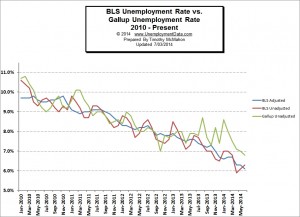The U.S. Bureau of Labor Statistics (BLS) released the June Unemployment figures on July 3rd. The Seasonally Adjusted Unemployment Rate was 6.1% down from 6.3% in May. The Unadjusted Unemployment rate was the exact opposite 6.3% in June and 6.1% May. So was the unemployment rate up or down?

Current US Unemployment Rate: 6.1% BLS or 6.5% Gallup
U-6 Unemployment
U-6 includes all classes of unemployed even those considered “marginally attached” and/or part-time for economic reasons. In other words, those who would like a full-time job but can only find part-time work.
According to the BLS the U-6 unemployment rate for June was 12.4% up from 11.7% in May. But Gallup says that the situation is actually much worse than that and their equivalent of the U-6 rate is at 15.8% but it is down significantly from May when it was 16.4%. See BLS vs Gallup Numbers.
Payroll to Population Rate
The payroll to population rate looks at a slightly different metric than the unemployment rate although at first blush it sounds similar. While the unemployment rate looks at the percentage of the “workforce” that can’t find a job (and a fairly narrow definition of the term workforce at that). Gallup’s Payroll to Population rate (P2P) looks at the percentage of the total population that is working. This number, in my opinion, is much less subject to fudging since although you can redefine the term “workforce” as evidenced by the various unemployment rates (U1 through U-6) it is much more difficult to redefine the total population of the United States.
Unlike the unemployment rate where a lower number is better, in the P2P, a higher number is better in that it indicates a greater percentage of the population is working. In June, Gallup’s P2P was 45.0% up from May’s 44.5%.
See Also:
- Current Employment Data
- Historical Employment Data Chart
- U-6 Unemployment Rate
- Unemployment Rate Chart
- Seasonally Adjusted Unemployment Rate in Table form
- Misery Index
